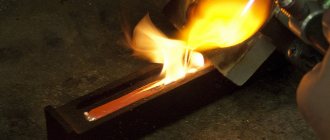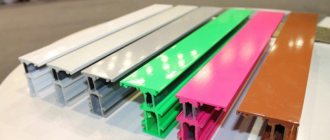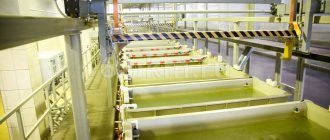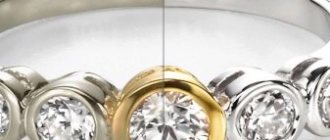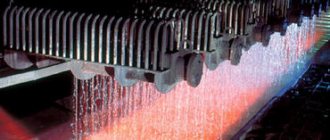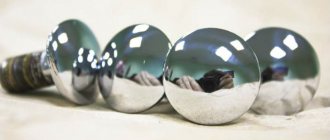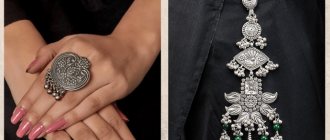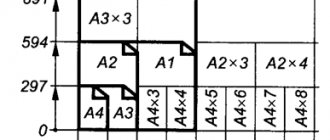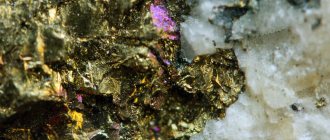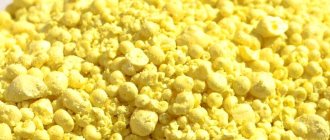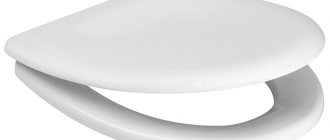Post updated: May 25, 2020
Products made from gold alloys of various grades are used not only as jewelry; parts made from precious metals are also actively used in industry. The use of pure gold in these cases is usually not economically justified; most often, only an external gold coating is required, which gives the element the necessary properties. Surface gilding is one of the main galvanic processes in jewelry, which allows giving the product the required decorative or technical characteristics. How is electroplated gold produced?
Gold plated jewelry
When they hear the word “jewelry,” many fashionistas imagine unremarkable plastic or metal jewelry that carries no value. High-quality costume jewelry cannot be classified as this type of product; even its base is made of cheap material. Craftsmen usually use base metals for the base of jewelry, and to give it an attractive appearance, they apply a beautiful coating using the galvanic method.
Cupronickel, bronze, brass, pewter or nickel silver are used to produce blanks for jewelry. All these alloys differ from each other in color characteristics and properties. Cupronickel is produced by alloying copper, iron, nickel and manganese. The result is an alloy similar in color to silver. Pewter is made from tin, which makes it easy to cast. Nickel silver is an alloy of zinc, nickel and copper, which, depending on the predominant element, acquires a tint of different shades. Bronze and brass contain copper, which makes their color quite attractive.
Craftsmen achieve the golden color and characteristic “precious” shine using electroplating. The base of the decoration does not have to be metal; it can also be a material of a non-metallic nature. During the galvanic process, the product is coated with a layer of gold or silver. In recent years, the rhodium procedure has often been resorted to.
Electroplating with gold provides the decoration with an attractive appearance. Reviews of such products are divided into two parts. Lovers of good jewelry speak positively, arguing that gold-plated jewelry has the effect of a precious metal, but for less money. High-quality coating and painstaking work of an experienced craftsman can bring the most daring design ideas to life. Others have a negative attitude towards products of this kind, since they only recognize precious jewelry.
What does gilding technology using gold leaf look like?
The first prerequisite when organizing work on dome gilding using gold leaf is a suitable temperature regime. The air temperature must be at least +14°C. Therefore, even if it’s spring, you need to take care of ensuring the “thermal circuit”. Work must be carried out in calm weather, ideally on scaffolding that is equipped with wind protection. This requirement is determined by the properties of the material - gold sheets are so thin and light that even with a slight wind, working with them can become impossible.
There are now big problems with training gilding masters. The fact is that there are no specialized educational institutions in Russia, and in functioning restoration and art universities only 4 academic hours are allocated for teaching gilding techniques. Out of despair, master gilders have to be “cultivated” by experienced craftsmen themselves, passing on their knowledge and all the experience gained in practice to their own students.
In general, the technology of applying gold leaf has a number of key stages. The first of these is cleaning and degreasing the surface of the domes. Then it is primed, and after the primer dries, it is covered with “backlight” - yellow-golden paint, which makes it possible to hide possible minor defects in the gold plating on the surface. After the “backlight” has dried, the surface is coated with moisture-resistant varnish.
As soon as the varnish layer has dried, the craftsmen move on to applying mardan, which is the name of the adhesive base for gold leaf. When it dries properly and acquires the necessary tack, gold begins to be applied on top. Place it on the surface using a “foot” - a specialized brush made of squirrel hair. If necessary, gold can be cut using a specialized knife. In order to avoid damage to the gold, this operation is performed on a specialized suede pad.
In general, the gilder’s set of tools is not so rich: this is a specialized knife for cutting gold, a suede cushion on which preliminary processing of gold raw materials is carried out, an oiler and a set of “paws” - used for applying and then leveling sheets of gold fan brushes on the base. squirrel fur. But the main thing for a master, of course, is skillful hands.
During the dome restoration process, all work is done upstairs. When building a new temple structure, everything can be individual. If the dome is small in size, then gilding can be done in a workshop or on a specially equipped area near the temple. If we are talking about large domes, then in order to avoid damage to the applied gilding during installation work, gilding is performed on the dome already installed on the temple, from scaffolding, and therefore is not always carried out in a comfortable position.
Methods of applying gold plating
Among the possible options for applying gilding, experts distinguish two methods: mechanical and electrochemical. The mechanical method involves covering the surface with gold leaf. Gilding with the thinnest sheets of metal has been used since ancient times; over many centuries, the essence of the procedure has remained virtually unchanged. Gold leaf plating can be oil-based or glue-based; in the first case, the metal is glued to oil varnish, and in the second, to polyment. The oil-based coating turns out matte; to achieve the effect of a shiny surface, experts resort to using an adhesive base. Work on creating an adhesive coating can be carried out exclusively indoors, since such gilding is characterized by high sensitivity to moisture.
The electrochemical version of surface treatment with precious metal is a galvanic method of applying gold to a product. What it is? During the work, the master applies, using electric current, a thin layer of yellow precious metal, the size of which can reach fractions of microns.
Like any coating, electroplating has its advantages and disadvantages over other options. There are quite a few advantages of coating obtained in this way. These include a high level of wear resistance, excellent reflectivity, high current conductivity, the ability to protect the product from aggressive external factors, the effects of corrosive and oxidative processes. When applying galvanic coating, the specialist carrying out the work can control the thickness of the precious metal layer. Due to the listed properties, galvanic gilding is widely used both in surface decoration and for creating technical parts of devices.
Electrochemical deposition of gold on the surface.
For a long time, the main disadvantage of the method was considered to be the limited scope of its application. The electrochemical method of applying gold to a surface assumes that this surface is conductive, that is, made of metal. Thanks to scientific advances, this problem has now been partially resolved: special technologies make it possible to gild dielectric materials using conductive varnishes and films.
Preparation and use of gold chloride
To gold-plate metal, a solution called gold chloride is often used. To prepare such a solution, gold is dissolved in “aqua regia,” which is a mixture of hydrochloric and nitric acids. Hydrochloric and nitric acids are taken in a ratio of 3: 1. Gold is placed in this composition, and then the liquid is evaporated. The procedure for evaporating liquid from such a solution should be carried out very carefully so as not to cause burns to the skin and respiratory tract. The dry substance remaining after evaporation is precisely gold chloride.
When evaporating, you need to separate the open fire from the container with the solution, for example, by making a layer of asbestos chips poured into a separate container
Before using gold chloride for gilding, it must be mixed with a solution of potassium cyanide and washed chalk, resulting in a paste-like mass. Using a brush, this paste is used to cover the product, after which it is left for some time, and then thoroughly washed and polished.
To gild steel, gold chloride is mixed with ether. The product coated with this composition is left for some time until the ether has completely evaporated, and then the treated surface is simply rubbed with a cloth to impart a golden shine.
Using gold chloride, previously mixed with ether, various inscriptions and patterns can be applied to a metal object. In order to carry out this procedure, a quill pen is dipped into the resulting solution and the required inscriptions and patterns are made, which, after evaporation of the ether and polishing, will sparkle with a golden sheen.
Large surfaces are covered with gold using a soft brush
As mentioned above, gold plating is often applied to silver, for which gold chloride can also be used. To perform chemical gilding of products made from this metal, it is necessary to prepare a mixture that includes the following components:
- gold chloride – 10 grams;
- potassium cyanide – 30 grams;
- table salt – 20 grams;
- soda – 20 grams;
- water – 1.5 l.
Chemical gilding, which must be applied to silver, can also be performed using a mixture of:
- gold chloride – 7 grams;
- potassium ferric sulfide – 30 grams;
- potassium carbonate – 30 grams;
- table salt – 30 grams;
- water – 1 l.
The procedure for sputtering a layer of gold onto a metal surface using chemical solutions is performed in the following sequence.
- The product being processed is pre-calcined.
- The surface of the object is etched first with a solution of sulfuric acid and then with nitric acid.
- The pickled product is momentarily dipped into a mixture consisting of sulfuric, nitric and hydrochloric acids.
- After treatment in a mixture of acids, the product is rinsed with water, then immersed in mercury and finally in water, where it is kept for 30 seconds.
- After a container of water, the product is placed in a solution for gilding, kept for the required time, then washed with water and dried in sawdust.
Gilding technology
Gold plating is a process of depositing a metal film. The thickness of the film can be different; depending on the purpose of gilding, a specialist can apply a layer on the product with a thickness ranging from a fraction of a micron to a fraction of a millimeter. The whole process is divided into three stages: first the surface must be prepared, then a layer of metal is applied and final processing is carried out.
A high-quality coating will only be achieved if the surface to be treated is well prepared. The product is pre-polished mechanically. To do this, use sandpaper, special pastes or grinding machines. Then the surface is degreased in an organic solvent. Alcohol, acetone or gasoline can cope with this task. Another mandatory procedure before galvanic treatment is pickling - removing existing contaminants, oxides and rust from the surface.
Sometimes it is necessary to electroplate only part of a part; for this, the remaining areas of the product must be protected from the effects of electrolyte and gold deposition. To do this, before applying the precious coating, acid-resistant varnish is applied to areas that are not subject to gilding.
The part is plated with gold using galvanic baths. The work is carried out using conductive suspensions and drums made of acid-resistant materials or in bell installations that ensure excellent electrical contact. The galvanic bath must also have an acid-resistant coating so as not to be destroyed under the influence of the electrolyte and equipment in the form of steam jackets. The entire process takes place at high temperature and the required current density, which are supported by automatic regulators. It is almost impossible to carry out galvanic procedures at home, since this requires not only special equipment, but also rare chemical reagents.
Upon completion of the work, the product is coated with a thin metal layer, which provides the best characteristics for the part. For decorative products, it is important to acquire an attractive appearance and the desired shade, for industrial parts - the ability to resist corrosion, improve electrical contact and facilitate the soldering process. Sometimes galvanic coating is used to increase the volume of a product. Depending on what properties need to be imparted to the part, electroplating can be done with both gold and other elements: silver, chromium, nickel.
Gold leaf
The word “leaf” itself comes from the concept “leaf” - i.e. “face” or “front surface”. The final result of a whole cycle of restoration work directly depends on the quality of gold leaf.
In general, there are about 30 technological operations for obtaining gold leaf ready for lining domes, and literally each of them has its own subtleties that affect the final result of the resulting product. If we describe this in a simplified form, the process looks like this. First, the gold is rolled into the thinnest strip. Then this strip is cut into squares, which are placed between sheets of specialized tackle (previously in Rus' beef casings were used for this, and in our time - special paper, as well as polymer materials) in a stack, which can contain from one hundred to three hundred such squares. Subsequently, this entire stack is flattened until literally each square is several hundredths of a micron thick.
Gold leaf is delivered to the site in the so-called. “books”, between sheets of paper of which gold sheets are inserted for greater safety. Inside such “books” there can be from five to sixty sheets of gold.
For dome gilding, heavy gold is used - having a ligature weight of 60 sheets from 2 to 6 grams. There is lighter gold, with a “book” weight of up to 2 grams, but it is used for internal gilding work. Experts warn that such gold should not be used for gilding domes .
Russian manufacturers have always made gold leaf in one size - 91.5x91.5 millimeters. Foreign manufacturers - from Germany and Italy - produce “books” of different sizes. Currently, their products, which are in high demand, are also present on the domestic market.
In the precious metals market, gold leaf is generally considered a product. At the same time, the product is far from cheap, because it always has a 960 standard. Such a high standard is explained by the gilding technology used - gold sheets must be extremely soft, and the use of any additives, even in minimal quantities, entails a loss of ductility. As a result, gold raw materials begin to wrinkle and even tear, which does not have the best effect on the quality of gold plating work and leads to its rise in price. After all, to eliminate defects - cracks, tears and visible mordan - the varnish used to glue gold - you have to take an additional volume of gold, which increases the consumption of material.
Gold alloy plating
To coat products, gold alloys are most often used, to which a ligating component is added. An additional element in the alloy allows you to give the part the necessary qualities and the desired shade. In Russia, preference is given to gold with a reddish tint; in the USA and some other countries, priority is given to coatings of lemon yellow or brass shades.
In order for electroplating to have a tint not like gold, but like platinum, the working alloy must consist of gold and nickel, the percentage of which must be at least 8-10%. This coating will have a white tint and will also be highly hard compared to a pure gold layer. The higher the proportion of nickel in the alloy, the higher the hardness and wear resistance of the final surface will be. Electroplating based on gold and nickel is used abroad for jewelry. Due to their high resistance to corrosion processes, they can also be used for technical purposes.
An alloy of gold and copper is used in Russia to coat elements of wristwatches. The progress of the process depends on the concentration of free cyanide in the electrolyte: the higher the concentration of the substance in the electrolyte, the lower the copper content in the resulting coating. When the process is carried out under conditions of neutral electrolytes, a copper-gold coating with a thickness of 20 microns can be obtained.
In addition to the listed alloys, gold-silver and gold-antimony compositions are also used. The percentage of elements in the final coating depends on the characteristics of the electrolyte and the chemical reagents used.
Gold-antimony electroplating has earned positive reviews for its use in gilding eyeglass frames. A coating of this composition is characterized not only by increased wear resistance, but also by an attractive appearance. Depending on the thickness, it can turn out semi-shiny or shiny. Such properties, together with a high level of resistance to mechanical stress, allow the alloy to be used for decorative purposes.
Methods and methods of gilding metal
The quality and appearance of the coating depend on the technology used. The most common methods of applying gold are:
- mechanical;
- chemical gilding using active substances;
- galvanic gilding.
For each method, different chemicals and tools are used.
Chemical method
Chemical gilding is the application of gold chloride to the item to be treated. To create a reagent, you must sequentially perform the following steps:
- The metal is broken into small pieces.
- The elements are placed in a pre-made mixture. The reagent is made based on a compound of hydrochloric (30 g) and nitric (10 g) acids.
- For each gram of spraying, about 10 ml of reagent should be consumed. Therefore, it is necessary to prepare the required amount of solution in advance.
Acids in everyday life should be handled carefully, avoiding contact with the skin of the hands and mucous membranes.
The ingredients are mixed in a porcelain flask, and dissolution can take three days. Once the preparation of the noble metal is complete, it is evaporated at 80 °C to form a liquid solution. To obtain a homogeneous composition of the required consistency during the evaporation process, the solution must be periodically shaken with a glass stirrer.
The following is prepared directly for the process:
- filtered water heated to 60 °C;
- golden chlorine salt – 15 g;
- sodium chloride or potassium carbonate – 65 g.
Items are processed after preparation has been completed in advance. To remove grease, it is recommended to wipe with 20% caustic soda, then wash in a 25% soda solution.
The item is placed in the mixture, and after a certain time (according to the type of metal) the surface turns gold-plated. After natural drying, the item is wiped with a soft, dry cloth. The surface is polished with a woolen cloth until it shines.
Mechanical gilding methods
Gilding gives the product certain properties that make it aesthetically attractive and resistant to environmental influences.
Mechanical processing is performed infrequently, because obtaining a uniform surface layer is not easy. This technology has the following features:
- It is necessary to use a special paste, produced in a special laboratory or independently. Paste ingredients may vary significantly for different products.
- The coating applied mechanically in domestic conditions, unlike galvanic coating, has a small thickness. Therefore, such products will not last long.
- The most common solutions are based on cream of tartar and yellow blood salt.
- To form a homogeneous porridge-like composition, rubbed into the surface of the product with a woolen rag, the substance is thoroughly mixed.
- Before applying gold plating, it is necessary to degrease the surface.
- The paste is applied in one layer with an even distribution of the golden mixture. When rubbing, it is necessary to avoid contact of the substance with the skin of your hands.
Mechanical gilding, unlike galvanic gilding, is a complex process, used in everyday conditions only for individual parts of objects. Other methods involve complete immersion of the part to be treated in a special solution.
Galvanic gilding of metals
Gold plating of sufficient thickness and quality is obtained by using a special technology that involves immersing the item in an electrolytic composition. The galvanic method is intended for processing products of almost any size; in fact, it is one of the types of electrochemical reactions.
It is necessary to take into account that the composition of the galvanic solution affects the shade acquired by the surface.
At home, an electrolytic solution for creating galvanic gold plating is prepared in the following sequence:
- 60 g of sodium phosphate is added to filtered water with a volume of 0.7 l;
- to dissolve 2.5 g of gold chloride, add 0.15 liters of water;
- 1 g of potassium cyanide and 10 g of sodium sulfide are dissolved in 150 ml of liquid.
When gilding using the galvanic method, the ingredients used to make the mixture must be handled carefully, avoiding spillage or contact with the skin, eyes, or mucous membranes.
The galvanic method involves heating the solution to 60 °C.
An anode is installed to electrolytically deplete and initiate reactions, reducing operating time and increasing the efficiency of the galvanic method. Gilding items in these solutions using the galvanic method takes about 15 hours, and a matte gold film is formed on the surface.
Electroplating
Common electroplating technologies have a number of disadvantages:
- Harmfulness - electrolytes are cyanide or conditionally cyanide-free. (cyanide compounds evaporate and poison the air);
- Expensive - high gold content in the electrolyte and professional equipment require significant financial costs;
- Complexity - the gilding process is complex and requires significant experience and knowledge;
- Disposal - Highly toxic used electrolytes must be disposed of. They cannot be poured down the drain or onto the ground!
Red gilding
One of the types of gilding performed in our company is red gilding, otherwise called Russian or red gilding. Gold-plated jewelry, which has reddish tints, looks the richest, as it resembles royal chervonets - coins for the production of which noble metal of 900 standard was used. Creating a “red” decoration for a client using red gilding will also not cause any difficulties for the craftsmen of our company.
Gordienko Anastasia Vadimovna Author of the materials Position: chief technologist of 6 Micron LLC Education: higher Experience in galvanizing: 11 years
No one has voted yet
Double gilding
This type of gilding can be called a real art. The most sophisticated clients will be delighted with the work of our company’s craftsman, who used double gilding. The meaning of fine jewelry work is to apply painting to the product using noble metal. It is performed in 3 stages:
- The top layer of the object, on which double gold plating will be applied, is carefully cleaned, leveled and covered with polyment.
- The main gold plating is applied to the layer prepared in this way.
- After the first layer has dried, the artist uses it to create a drawing in gold of a different shade.
This delicate work is also within the capabilities of our company’s craftsmen. Any client will be delighted with the results obtained and will turn to us with a similar request more than once.
Chemical gilding
Chemical gilding has now begun to gain great popularity due to its advantages. This is one of the most difficult ways to coat metal surfaces with gold, but despite this, the craftsmen working in our company successfully cope with it. Such spraying is required in the following cases:
- Protection of instruments and valuable equipment from negative environmental factors that provoke damage by atmospheric corrosion.
- Adding nobility and decorativeness to watch and jewelry products.
All products that have gone through this gilding method in our research and production company acquire not only a beautiful color, but also high chemical resistance. This type of coating with a layer of noble metal is used for nickel, bronze, brass, and copper.
Restoration of gilding
Has the gilding lost over time or lost its former rich appearance under the influence of unfavorable atmospheric factors? No problem. It is worth turning to the craftsmen of 6 Micron LLC for help, and jewelry or gold-plated household items that have become unpresentable will return to their original shine and rich appearance in the shortest possible time. A huge number of products requiring restoration of gold plating, both modern and ancient, have passed through the hands of the employees of our production and research company, so they have extensive experience in this matter, allowing them to fully satisfy the needs of the most demanding client.
